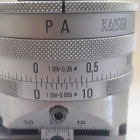The Kaiser Piccolo is an exquisitely made mid sized boring head with boring and automatic facing functions. I got a ISO30 one in a very nice condition together with a bunch of tooling. When tested it performed very fine but I couldn’t switch easily between facing and boring (marked as P and A in the head, maybe for the french «planage» and «alésage»). It needs to be serviced to cope with this jam.






